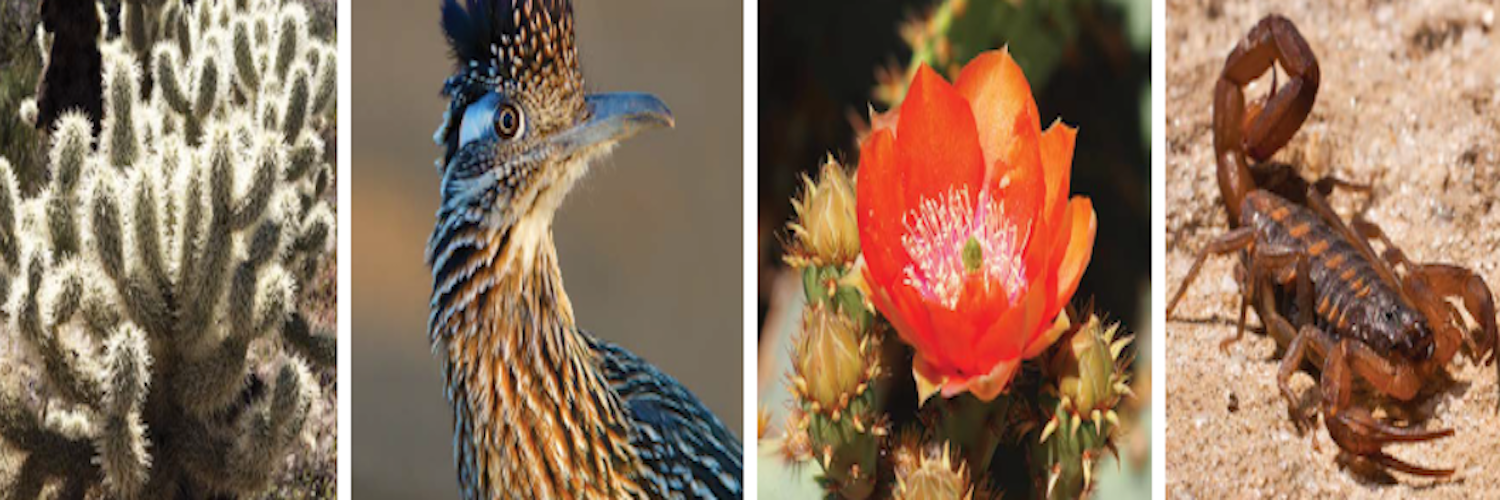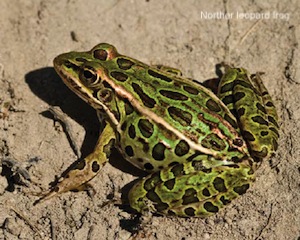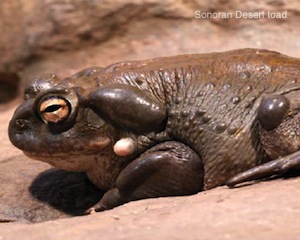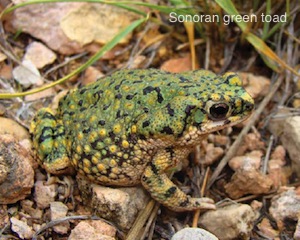
Frogs—Unexpected Desert Inhabitants
 In all, around 4,500 species of amphibians occur around the world, but only a few dozen are found in the Southwest. All of our desert amphibians, with the exception of toads, require access to a water source to keep their skin moist. Not surprisingly, our arid Southwestern deserts are not ideal habitat for many such creatures.
In all, around 4,500 species of amphibians occur around the world, but only a few dozen are found in the Southwest. All of our desert amphibians, with the exception of toads, require access to a water source to keep their skin moist. Not surprisingly, our arid Southwestern deserts are not ideal habitat for many such creatures.
Nonetheless, a number of frogs and toads are found in the Southwest, and their special adaptations help them survive here. Many species are inactive or underground during the height of the desert heat, and some species can even sense when rainstorms are approaching (by feeling the vibration from thunder). After a storm in the desert, a chorus of frogs might just surprise you!
 Sonoran Desert toads (Colorado River toads) are olive, gray, or dark brown in color, and the underparts are lighter in color. The skin is mostly smooth and shiny. There are warts around the edge of the mouth and on the hind legs.
Sonoran Desert toads (Colorado River toads) are olive, gray, or dark brown in color, and the underparts are lighter in color. The skin is mostly smooth and shiny. There are warts around the edge of the mouth and on the hind legs.
Northern leopard frogs are green or brown with large dark spots, with light edges on the back and sides. Light-colored ridges run from the back of the eyes to the rump. There is a light-colored stripe on the upper jaw. The snout is pointed and the hind toes are webbed.
Great Basin spadefoots are olive to green-gray above with a white belly and red spots on the back. There are gray streaks on the back, a glandular bump between the eyes, and a black wedge-shaped spade on each hind foot. Bullfrogs are green to brown on the back and may have darker spots. The underparts are a lighter color. The upper jaw may be light green and there are dark bands on the legs. The external ear coverings (known as the tympanic membranes) are large and impossible to miss, especially in males. The hind feet are webbed, with the exception of the longest toe.
 Sonoran green toads have green or yellow-green spots surrounded by black; their underparts are lighter. Males have a dark throat. Sonoran Desert toads are large toads, ranging 3–7 inches long. Northern leopard frogs are small frogs, around 2–5 inches long. Great Basin spadefoots are small and 1.5–2 inches long. Bullfrogs are the largest frog in North America at 3.5–8 inches long. Sonoran green toads are 1.5–2.25 inches long. Sonoran Desert toads live 10–20 years; Spadefoot toads can live up to 20 years. Frogs live 3–5 years or longer. Sonoran Desert toads, leopard frogs, Great Basin spade foots, bullfrogs, and Sonoran green toads eat insects, spiders, and lizards.
Sonoran green toads have green or yellow-green spots surrounded by black; their underparts are lighter. Males have a dark throat. Sonoran Desert toads are large toads, ranging 3–7 inches long. Northern leopard frogs are small frogs, around 2–5 inches long. Great Basin spadefoots are small and 1.5–2 inches long. Bullfrogs are the largest frog in North America at 3.5–8 inches long. Sonoran green toads are 1.5–2.25 inches long. Sonoran Desert toads live 10–20 years; Spadefoot toads can live up to 20 years. Frogs live 3–5 years or longer. Sonoran Desert toads, leopard frogs, Great Basin spade foots, bullfrogs, and Sonoran green toads eat insects, spiders, and lizards.
Sonoran Desert toads even eat other toads. Toads and frogs are nocturnal; they are easiest to observe after rainstorms. Toads and frogs burrow underground during periods of drought and exceedingly warm weather.
Note: Toads and dogs don’t mix too well! Sonoran Desert toads pack a powerful toxin in their skin, and they use this as a defensive mechanism. Animals that lick or bite the toad are quickly affected by the potent toxin. The toxin is absorbed through the lining of the mouth, and symptoms include foaming at the mouth, confusion, labored breathing, temporary paralysis, and convulsions! The toxin can kill a dog; if one comes into contact with a toad, it’s important to rinse the dog’s mouth with water from a hose and seek a veterinarian’s attention as necessary. Most dogs steer clear of toads after an encounter!
Many frogs and spadefoots have powerful skin secretions that can cause allergic reactions in humans. Handling them often results in a burning sensation, sneezing, a runny nose, or watery eyes. If you touch one, you should immediately wash your hands; or, better yet, just leave them alone!
For more fascinating insights into desert life, check out Karen Krebbs’ book Desert Life: A Guide to the Southwest’s Iconic Animals & Plants and How They Survive.


